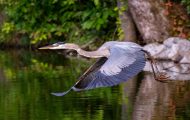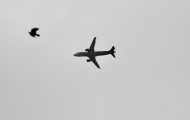Have you ever experienced a persistent backyard intruder with feathers and wings? While having birds around can be pleasant, they could rapidly become a nuisance if you end up with them. It’s time to take action and discover how to permanently eliminate these uninvited visitors if there are too many birds or they are really harming your property.
Even if you think it’s impossible, there are now straightforward ways to assist you in keeping the birds away using nonlethal means. Understanding the many tactics available allows you to handle your feathery companions without resorting to violence or becoming frustrated. After all, the majority of us don’t like stray birds staying around.
We’ll discuss how to get rid of unwanted birds on your property in this article so you may resume enjoying nature without having to deal with the drawbacks of having an excessive number of birds.
The Most Common Bird Species
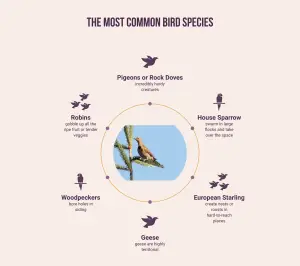
Before tackling your bird problem, it’s important to understand which birds are causing the trouble in the first place. The most common backyard birds are:
🐦 Pigeons or Rock Doves
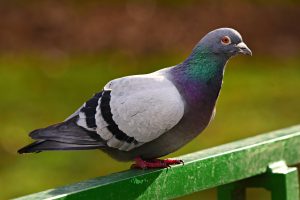
Pigeons, or rock doves, are one of the most common unwelcome guests in many backyards. They tend to flock together and can grow in large numbers very quickly. They not only occupy a space that may have otherwise been yours but also cause extensive mess and destruction. It makes them even less desirable.
Pigeons can be difficult to get rid of as they are incredibly hardy creatures, so once they decide your yard is their home, evicting them is nearly impossible. Not only this, but if enough food is available in the area, such as spilled seeds or bird feeders, more and more pigeons will come around, making the issue bigger and bigger.
As an urban dwelling species, pigeons live off of whatever food sources humans provide for them, so something as simple as leaving out leftovers on our balcony can inadvertently cause an increasing pigeon problem.
🐦 House Sparrow

When it comes to unwanted bird species, house sparrows typically come at the top of the list for many backyard bird lovers. These birds can be quite pesky and seem to be everywhere. They often build nests or roost in window sills, gutters, shutters, and awnings.
Those with feeders can swarm in large flocks and take over the space quickly, pushing out other smaller birds that could benefit from the primary food source. Besides just being a nuisance by monopolizing feeders, house sparrows can also be quite aggressive. They’re known to gang up on larger birds and attack them when defending their territory.
While most see them as pests, it’s important not to forget that these birds are part of a delicate ecosystem.
🐦 European Starling
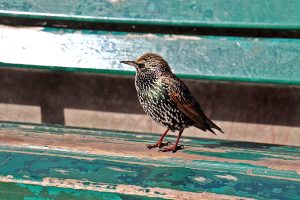
These birds are medium-sized, and their distinctive black feathers easily identify them from other birds. During the breeding season, these birds form huge flocks that can be so loud you’ll think there’s a party in your backyard! They like to hang out around outdoor lights and often create nests or roosts in hard-to-reach places such as gutters, chimneys, porches, and attics.
They will also eat just about anything they find, which can easily disrupt any existing bird feeder precious seed mix! Besides being loud, messy, and obnoxious guests, another downside to having the starlings in your backyard is that they carry diseases such as salmonella and E. coli which can be dangerous to humans if we come into contact with their droppings.
🐦 Geese
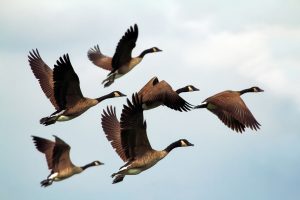
Geese can cause headaches for homeowners. Bird nests often result in a mess scattered everywhere, leaving yards looking unkempt and not to mention all the bird droppings that occur. It’s no secret why most find them to be an eyesore. Having a family of geese living on your property may seem charming.
However, dealing with the mess they leave can quickly become a hassle. Unfortunately, geese are highly territorial and do not take kindly to any disruption. Hence, having them on your property can become even trickier if you plan on removing them gently.
🐦 Woodpeckers
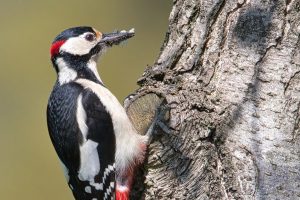
Woodpeckers make a lot of noise with their hammering on trees, homes, and other buildings, which can be quite irritating. They also bore holes in siding, fascia, and trim searching for insects, or due to their habit of building nests. Woodpeckers often leave behind visible signs like chipped paint on whatever they are pecking at. Additionally, birds nesting in inconvenient places can be hazardous as they may build nests up against exhaust vents, which may affect the efficiency of dryer venting systems.
🐦 Robins
These birds are often the first signs that spring is near due to their distinct bright orange feathers and red breast – they certainly make quite a splash of color! They might not be considered pests, but robins can still cause some trouble for gardeners.
The little birds have been known to gobble up all the ripe fruit or tender veggies from gardens, leaving behind empty reminders of what once was there! It is also important to remember that these birds get into all kinds of messes, including disturbing water sources or stepping in mulch. Sometimes slowing down garden work.
The Risks Associated With Birds
Sadly, birds occasionally cause problems. You can run into a number of issues you didn’t anticipate if a flock of birds decides to settle in and claim your home. These bothersome feathered buddies have a variety of ways to harm people and property, including aggressive behavior outside of your home and collisions with wind turbines.
Unwanted bird populations can steal food supplies from other animals and scare them off your property.
Nesting may also cause obstructions that cause a wall or ceiling to fall. Roosting birds’ claw marks can damage a building’s paint job and even permanently scar the surface of glass panes. Moreover, bird droppings are unattractive, unhygienic, and can spread diseases.
Also, when nesting, birds frequently bring unpleasant odors and loud sounds that might disturb nearby people and animals. Yet, the most harmful effect of unwelcome birds on the land is that they disturb crops by eating product or preventing it from growing to their full potential.
The Early signs of a Bird Infestation in Your Home
If left unchecked, a bird infestation in your home can quickly worsen. To prevent this from happening, it’s important to recognize the signs of a bird infestation early on. These signs include:
📍 Listen for Strange Sounds
Birds can be pretty vocal, especially during mating or feeding times. If you start hearing chirping, cooing, squawking, or flapping sounds that you haven’t heard before, especially in the early morning or evening, it could be a sign of the presence of birds in your attic, chimney, eaves, gutters, or vents.
Some common bird species seeking shelter or food in homes include pigeons, sparrows, starlings, swallows, and woodpeckers.
📍 Observe for Nesting Materials or Debris
Birds need materials to build their nests, such as twigs, grass, feathers, or mud, and they tend to collect them from nearby sources. Therefore, if you spot piles of these materials near your home, roof, or garage, it can indicate that birds are preparing to nest on your property.
Birds can also leave messy droppings, feathers, or debris around their nesting sites, posing hygiene and safety risks. Look out for these signs of bird activity, and clean them up as soon as possible to prevent further damage and contamination.
📍 Check for Physical Damage
Birds are not only noisy and dirty but also potentially destructive. Some birds, like woodpeckers, can drill holes in your wooden sidings, fascia, or roofs, looking for food or mates. Other birds can scratch, peck, or puncture your surfaces or cause clogging by nesting in your vents, chimneys, or gutters.
If you notice any visible damage to your property that seems to have been caused by birds, don’t ignore it or try to fix it without addressing the bird problem first.
📍 Look for Bird Droppings or Smells
Bird droppings can reveal much about the type and size of the bird population in your vicinity and can also pose health hazards to humans and pets. Therefore, if you notice any unusual bird droppings on the ground, walls, or furniture, don’t touch them with bare hands or inhale their fumes.
Wear gloves and a mask, and clean the area with a mild bleach solution or other bird-deterrent products. Also, bird smells, such as ammonia or musty odors, can indicate that birds have been living or roosting in your home for a while, and you might need professional help to remove them safely.
How to Get Rid of Unwanted Birds On Your Property
Once you’ve identified the signs of a bird infestation on your property, taking action immediately is important. The following are some of the most effective methods for getting rid of birds on your property:
🕊 Deploy Bird Roosting Spikes
Bird roosting spikes, ever heard of them? It might seem very specific, but they’re incredibly helpful in getting rid of unwanted birds on your property. With these tools, you can keep pesky feathered guests away without resorting to any unpleasant measures or tactics.
So what exactly are bird spikes? Well, they’re metal spikes with an adjustable angle that stick out from metal bases. They can be installed onto patio overhangs, ledges, or anything that birds could use as a resting spot or roosting ground.
When birds try to land on these surfaces, they feel an uncomfortable sensation from the metal spikes, which stops them from stopping there. It’s a convincing yet humane way of keeping unwanted avians away from your property, as it won’t hurt them if handled properly.
If you choose this method for ridding yourself of unsighted feathered visitors on your premises, ensure that the installation conforms to local laws and ordinances regarding animal wildlife protection. Some places may have rules prohibiting or limiting the usage of bird-repelling devices such as these spikes.
As long as you consider this beforehand, using bird roosting spikes should be an effective and non-invasive solution for your unwanted avian problem!
🕊 Install a Motion Activated Sprinkler
Another option that’s gotten a lot of positive reviews lately is installing a motion-activated sprinkler. It might sound strange, but it is quite effective! Installing a motion-activated sprinkler is not difficult. Just identify where the birds are finding shelter and aim the nozzle at the branch or other area they’re using.
When one of the pesky birds enters the area, motion sensors trigger a continuous stream of water. The surprise effect will cause even the most determined birds to scramble away. Of course, you’ll want to adjust your nozzle according to the weather and ensure there’s enough pressure in your hose so that the water comes out in a gentle mist instead of powerful jets.
That way, no bird will be harmed, and it’ll be more effective in scaring them away. This method works best if done regularly, as birds may quickly become accustomed to it if you only turn it on occasionally.
🕊 Remove Food Sources
Basically, you need to make sure that these birds don’t have anything to eat or drink in your yard and garden. Start by removing any bird seed that may be left out; instead of feeding birds, try planting native plants and flowers that will attract wildlife, such as butterflies or hummingbirds.
If there are ponds or lakes on the property, get rid of sugary drinks or exposed pet food containers commonly used as water and food sources for birds. This can help reduce their likelihood of staying on the property.
Finally, be sure to clean up any edible items that may be left behind from time to time – this includes fruits fallen from trees and spilled birdseed scattered around the lawn by neighborhood squirrels.
🕊 Apply Liquid Bird Repellent
Another effective way of deterring birds is by applying liquid bird repellent. The most important factor here is finding a quality product – any liquid bird repellent should be easy to apply, safe for the environment and health, and effective in keeping target birds away from your property.
To apply the repellent, simply spray or paint it onto surfaces such as windowsills and doorways where the birds like to nest and roost. The scent or taste of the liquid usually sticks around long enough to make them uncomfortable. For this reason, they find somewhere else to go.
Another benefit of applying liquid bird repellent is that it won’t cost you much money or time. A single application can keep unwanted birds away for weeks at a time!
🕊 Block All Openings On Your Property
Make sure you take the time to inspect your property. Block any openings that may be providing birds with access to food or shelter. This prevents birds from entering and nest in the area, making it difficult for them to stay around long-term. In order to block off these openings properly and with long-term results in mind, be sure to use a solid and snug material that can’t easily be pulled away or deteriorated by elements.
The size of the netting should also extend beyond the opening by several inches. Hence, there isn’t any room for a bird to fit through small spaces between the edges. Additionally, including covers over chimneys helps prevent birds from entering and uses caps designed specifically for this purpose.
🕊 Install Bird Netting
Bird netting is a great solution for deterring birds from making homes in places that are not ideal for them. Installing bird netting can effectively block the openings they use to access places like attics, eaves, and ventilation systems while still being easy to handle. This method requires careful attention to detail. Proper placement and installation of the netting make all the difference in preventing additional infestations.
Though it may feel intimidating, installing bird netting on your property does not have to be complicated or time-consuming. In no time at all, you can have a barrier between your house and any birds looking for a place to perch and roost! As long as you keep up with cleaning, bird netting is reusable. Therefore, once it has served its purpose, you can put it away until needed again.
🕊 Implement Audio Deterrents
Audio deterrents work by emitting sounds that distress birds and act as a signal that they are unwanted. The noise emitted needs to be loud enough for the birds to hear but not so loud it’s unbearable for humans. Depending on the types of birds on your property, you’ll need to adjust the type of sound-projecting device and the length of time it’s active.
Once implemented, the birds should flee from your area quickly, which helps keep them away from adjacent areas too.
🕊 Install Reflective Materials
Reflective materials like mirrors, aluminum foil, and even reflective window strips can create a “hostile” environment for birds, which will cause them to stay away. These work because the surface reflects the area around it, creating an illusion of more humans or predators than actually exist there. This causes the birds to feel threatened and fly away from your property in search of safer places.
Installing reflective materials isn’t too difficult either – you can hang large pieces of your chosen material near bird-friendly areas such as windowsills or plants to scare them off effectively while still being non-defensive (i.e., not directly attacking them). Plus, you don’t have to worry about harming the birds either – they will flee after seeing their own reflection!
🕊 Leave Some Decoy Predators
If you’re having trouble getting rid of nuisance birds from your property, then consider setting up some decoy predators. To do this, simply choose a suitable and visible spot on your property and place the decoy. Many people choose to go with a fake owl as they are natural bird predators, but fake cats or snakes can also do the job just as well. You can also purchase realistic-looking decoys from garden centers or online stores.
Make sure to move the predator around occasionally and spook it up with motion-activated sounds if you want to make an impression. When done right, this should scare off any unwelcome visitors within a few days. However, it’s important to note that the birds may eventually return when they realize the predator is not a real threat!
🕊 Hang Porcupine Wire on Your Gutters
Essentially this is a type of wire mesh with finely-spaced prongs or barbs that form a sharp obstacle when hung along gutters and other potential bird perches. By installing it on your gutters, the birds will find it uncomfortable somewhere to rest, so they go somewhere else.
The good thing about porcupine wire is that it’s relatively low-cost and easy to install yourself. No special tools are needed.
First, cut the wire slightly longer than your gutter length. Then attach one end of the wire to the back edge of the gutter at one corner. After that, stretch down in a straight line to the opposite corner, where it needs to be secured with staples or screws onto the front edge of the gutter. This method should provide enough resistance for most small birds, like sparrows and starlings, which tend to cause most problems for homeowners.
Thus, you no longer have to worry about unwanted birds causing a nuisance!
🕊 Hang Around Outside With Your Pets
Taking your four-legged pal for a stroll around your property isn’t just good exercise for both you and your pet. It can also help you get rid of unwanted birds too. To do this effectively, take the time to be present in areas where birds usually hang out on your property. This could be near a garden, a bird feeder, or some type of bird bath.
By hanging around with your pet in the area, birds naturally become wary and shy away. Depending on how territorial they feel towards one another, they may even start fighting to protect that space. Keep in mind, though, that this method is best used with larger pets – things like dogs and cats – as smaller pets may not be enough of a deterrent.
In any case, it’s best to ensure that your pet is securely leashed up when trying this method. Thus, you don’t suddenly have them chasing after an unsuspecting winged creature!
🕊 Set a Scarecrow
Setting up a scarecrow is one of the most reliable methods to get rid of unwanted birds on your property. This benign solution works well in urban and rural settings and is surprisingly easy. For urban spaces, you will want a four-sided box with some type of visual reflection on the front that can be seen from a distance, like metal tinfoil strips.
You’ll need something more substantial for wooded areas and rural locations. An old mannequin or chimney brush stuffed with straw makes an effective deterrent. To complete your scarecrow, add distinctive clothing or a hat to the figure to make it appear even more threatening. Finally, prop the figure strategically. Maybe near your garden patch or at the entrance of your yard – and enjoy wingless peace!
🕊 Call a Professional Pest Control Services
If you’ve got unwanted birds on your property, one of the best options is to call a professional. Pest control experts know exactly how to deal with large populations of birds, as well as their nests and eggs. Bird control specialists can safely remove the birds without harming them while keeping humans and pets out of harm’s way simultaneously.
The process typically begins with an inspection – bird removal professionals will assess the situation and determine the best course of action for your specific needs. Once that’s complete, they’ll set up a plan for getting rid of the pest birds, including things like netting, exclusion devices, gel dispersal systems, and more.
In some cases, trapping may even be necessary to capture offending birds. But whatever it takes to get rid of those pesky avians from your property, rest assured professionals will have everything under control in no time at all!
Frequently Asked Questions
Q: What do you mean by Migratory Bird Treaty Act?
The Migratory Bird Treaty Act (MBTA) is a law originally passed in 1918 in order to protect migratory birds from the threats posed by commercial hunting and trade. This landmark treaty has been amended several times over the years. However, it’s still all about protecting the future of bird populations like cranes, ducks, geese, and doves traveling long distances between their winter habitats and summer homes. Many birds are impacted by pollution, deforestation, and pesticides. The MBTA works to protect them by prohibiting some forms of hunting, trapping, selling, and even possessing certain species or their parts without permits or exceptions granted under the U.S. Fish & Wildlife Service regulations.
Q: What are the most unwanted places for birds to nest?
There are a few places that birds really don’t like to nest – gutters, attics, and porches especially. While gutters may seem like a good fit for small birds, most of them don’t enter them at all because not only are they usually narrow, and there isn’t much shelter or protection from the weather for eggs, but they can also be dangerous with all the water rushing around. Attics could be more appealing, although bigger species might try to carve a niche in one if they’re desperate enough. These areas tend to be full of dirt and debris generated by humans and animals (not just nesting material) and excess heat since they aren’t generally well-ventilated.
Q: Can a wild bird cause damage to my property?
Wild birds can indeed cause damage to your property, although it largely depends on the size and number of birds. If you spot one bird pecking at your windows or gutters, it likely won’t cause any real harm. However, substantial repairs may be required if a flock is roosting in your eaves or causing damage to the outside of your home, such as chewing through wood trim or siding. Additionally, wild birds can also bring pests and parasites to your property. Plus, the mess from droppings may need to be cleaned up. In such cases, contacting a pest control professional for assistance in ridding yourself of the problem properly is important.
Q: How does the wildlife control process work?
The process begins when you contact a certified and experienced professional who will assess the situation. Typically they will offer advice as well as options for remedying the problem. They’ll also take into account any relevant laws or regulations that may be in place in your area, such as those concerning trapping or relocation. And they can help to ensure that the necessary preventative measures are put in place going forward. Therefore, hopefully, you won’t have any more surprise visitors!
Q: When is the best time to get rid of birds?
When it comes to getting rid of birds, timing is absolutely key. The absolute best time to eradicate these pesky birds is when they’re nesting. This is the point at which their numbers are minimal and, thus, easier to handle. Another great time to take action is in the late summer or early fall when the population typically starts growing again after a decline over winter. This way, you can nip an increase in numbers before it gets out of hand. However, no matter which season you decide to launch your defense against these winged creatures, remember to work humanely. There are plenty of humane ways to scare away birds without causing them any harm!
Final Words
All in all, getting rid of unwanted birds doesn’t have to be complicated. Depending on the bird you’re dealing with and how it is making its presence known, you can take steps to remove them effectively from your property. From scaring them away or discouraging their behavior with non-lethal hazing measures to contacting an animal control officer or wildlife rehabilitator who can properly relocate the bird without causing injury. Remember, the key is being persistent while following safe and humane practices. Ultimately, if all else fails, keep a helpful supply of water balloons handy as a last resort.

